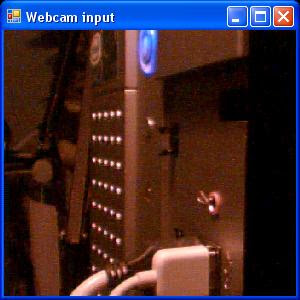Converting image to gray scale
Many image processing operations and algorithms are defined for grayscale images. A simple way to convert the image to grayscale is the following:
let grayGrabber(transform) =
fun (width,height) ->
{ new ISampleGrabberCB with
member this.SampleCB(sampleTime:double , pSample:IMediaSample )= 0
member this.BufferCB(sampleTime:double , pBuffer:System.IntPtr , bufferLen:int) =
let grayImage = getGrayImage pBuffer bufferLen
let resultImage = transform width height grayImage
saveGrayImageToRGBBuffer resultImage pBuffer bufferLen
0
}
Given that we have:
let inline getGrayImage (data:IntPtr) (size:int) =
let grayImage = Array.create (size/3) (byte(0))
let pixelBuffer = Array.create 3 (byte(0))
let mutable it = 0
for i in 0..(size - 3 ) do
if (i + 1) % 3 = 0 then
Marshal.Copy(new System.IntPtr(data.ToInt32()+i),pixelBuffer,0,3) |> ignore
grayImage.[it] <- byte(float(pixelBuffer.[0])*0.3 +
float(pixelBuffer.[1])*0.59 +
float(pixelBuffer.[2])*0.11)
it <- it+1
grayImage
let inline saveGrayImageToRGBBuffer (grayImage:byte array) (data:IntPtr) (size:int) =
let mutable targetIndex = 0
for i in 0..(size/3 - 1) do
let p = grayImage.[i]
Marshal.WriteByte(data,targetIndex,p)
Marshal.WriteByte(data,targetIndex+1,p)
Marshal.WriteByte(data,targetIndex+2,p)
targetIndex <- targetIndex+3
()
The technique for converting the image to grayscale was taken from here.
Using this new grabber definition we can change the code from the previous post to do this:
let mediaControl,filterGraph = createVideoCaptureWithSampleGrabber
device
nullGrayGrabber
None
Given that
nullGrayGrabber is defined as:let nullGrayGrabber = grayGrabber (fun (_:int) (_:int) image -> image)
The original webcam output looks like this:

By applying this filter the webcam output looks like this:

Applying templates
With this definitions we can do a common operation in image processing called template convolution. Basically, this technique consists in applying an operation to each pixel of an image and its surrounding neighborhood . The operation is represented by a matrix, for example:
0.0 1.0 0.0
1.0 -1.0 1.0
0.0 1.0 0.0
To apply this template to the a pixel of the image at x',y' we write:
(0.0*image[x-1,y-1]) + (1.0*image[x,y-1]) + (0.0*image[x+1,y-1]) +
(1.0*image[x-1,y]) + (-1.0*image[x,y]) + (1.0*image[x+1,y]) +
(0.0*image[x-1,y+1]) + (1.0*image[x,y+1]) + (0.0*image[x+1,y+1])
The function to apply this kind of operation looks like this:
let convolveGray3 w h (image:byte array) (template:float[,]) hhalf whalf =
let result = Array.create (image.Length) (byte(0))
let getPixelGray' = getPixelGray w h image
let setPixelGray' = setPixelGray w h result
for y in (hhalf + 1) .. (h - ((Array2D.length1 template) - hhalf - 1) - 1 ) do
for x in (whalf + 1) .. (w - ((Array2D.length2 template) - whalf - 1) - 1 ) do
let mutable r = 0.0
for ty in 0 .. (Array2D.length1 template - 1) do
for tx in 0 .. (Array2D.length2 template - 1) do
let ir = getPixelGray' ( x + (tx - whalf)) ( y + (ty - hhalf))
r <- r + template.[ty ,tx ]*float(ir)
setPixelGray' x y (byte(Math.Abs r))
resultGiven that:
let inline getPixelGray width height (image:byte array) x y =
let baseHeightOffset = y*width
let offset = baseHeightOffset + x
image.[offset]
let inline setPixelGray width height (image:byte array) x y value1 =
let baseHeightOffset = y*width
let offset = baseHeightOffset + x
image.[offset] <- value1
()We can represent operations such as edge detection or smoothing.
First order edge detection can be represented using the following template:
let firstOrderEdgeDetectTemplate =
(array2D [|[|2.0;-1.0|];
[|-1.0;0.0|];|])
Changing the code of the main program to the following:
let convGrayGrabber1 =
grayGrabber (fun width height grayImage -> convolveGray3 width height grayImage firstOrderEdgeDetectTemplate 0 0 ) Now the output looks like:

We can also use a template template to represent averaging. This technique removes detail from the image by calculating the average value of pixel given its neighborhood. The definition of a function:
let averagingTemplate (windowSize) =
Array2D.create windowSize windowSize (1.0/float(windowSize*windowSize))This function creates a template which looks like this:
> averagingTemplate 3;;
val it : float [,] = [[0.1111111111; 0.1111111111; 0.1111111111]
[0.1111111111; 0.1111111111; 0.1111111111]
[0.1111111111; 0.1111111111; 0.1111111111]]
We can change again the main program to use this function:
let averagingGrayGrabber =
let template = averagingTemplate 3
grayGrabber (fun width height grayImage -> convolveGray3 width height grayImage template 1 1 )
...
let mediaControl,filterGraph = createVideoCaptureWithSampleGrabber
device
averagingGrayGrabber
NoneThe result image looks like this:

Final words
As with the previous post I'm using mainly the imperative features of F# . For future posts I'll try change this and also continue the exploration of image processing with F#.
Most of the techniques described here were taken from the "Feature Extraction & Image Processing" book by Mark S. Nixon and Alberto S. Aguado.
Code for this post can be found here.